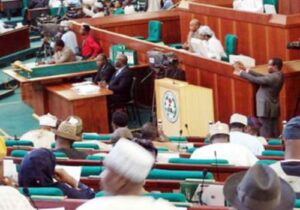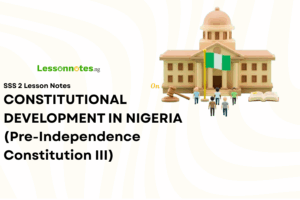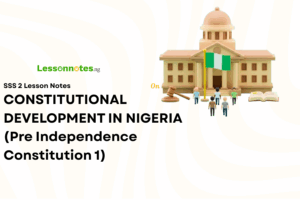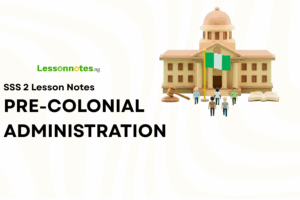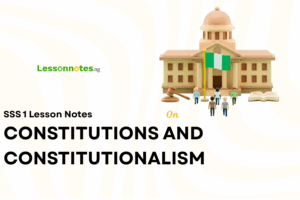Constitutional Development II SS2 Government Lesson Note
Download Lesson NoteTopic: Constitutional Development II
RICHARD’S CONSTITUTION OF 1946
During the Second World War (1939-44), Sir Bourdillon was governor of Nigeria. When he retired in 1944, he had almost concluded the constitution where he proposed regionalism. His successor Sir Arthur Richard used his proposals to draft his constitution. He presented it to the legislative council of Nigeria on March 6, 1946; it became a constitution on August 2, 1946 and came into force on January 1, 1947. The new constitution was meant for the unity of Nigeria and encouraged greater participation of Nigerians in their affairs.
Aims And Objectives Of Richard’s Constitution
- To create a regional council for the three regions of north, west, and east i.e. regionalism.
- To promote the unity of Nigeria.
- To allow greater participation of Nigeria in their affairs.
- The legislative council was introduced to accommodate every section of the Nigerian.
- To divide the country into three administrative units north, east, and west.
- To create constitutional and political links between the native authorities and the legislative council.
Features Of Richard’s Constitution
i. The Executive Council: The central executive council had Richard as the president of the council and was dominated by Europeans.
ii. The Legislative Council: The government was the president and was based in Lagos. The council allowed a wider representation of Nigerian interests. It had 44 members made up of 28 majority non-officials and 16 minority officials. The composition was
iii. The North had 9-non official members
iv. The West had 6-non official members
v. 4 non-official members were nominated to represent commercial banking and mining.
vi. 4 non-official members were elected directly from Lagos and Calabar.
vii. 16 official members, 13 of whom were ex-official and 3 nominated.
viii. The qualification to vote was restricted to male adults who resided in the area for 12 months with a gross income of E50 per annum.
ix. House of Assembly or Regional House of Assembly: Assembly members were to be elected by the native authorities while the regional assembly members were to elect members of the Central Legislative Council (through electoral colleges).
x. The elective principle: The constitution still retained the elective principle with the limited franchise of 3 representatives from Lagos and 1 from Calabar.
xi. Legislature: It brought the North and South together under one legislature
xii. Dual Membership: Members of the Central Legislative Council were also members of the Regional Council.
xiii. Nigerians were in the minority in the Nigeria Central Executive Council.
xiv. Regionalism: Regions were created out of the former three provinces -Eastern, Western and Northern regions.
Merits Of Richard’s Constitution
i. The constitution brought the North and South together and this laid the foundation for national unity.
ii. Nigeria’s formed the majority in the legislature though in an unofficial capacity. Members were in the majority for the first time.
iii. The constitution introduced a bi-cameral legislature in the North, thus it introduced bi-cameralism in Nigeria.
iv. Regionalism was introduced in Nigeria and this was a good achievement of Richard’s constitution.
v. The constitution laid the foundation for Federalism and Federal Constitution in the Nigerian political structure.
vi. The North and South were integrated for the first time since 1923 for registration and unity purposes.
Demerits Of Richard’s Constitution
i. The executive council was still dominated by Europeans just as in Clifford’s Constitution.
ii. The constitution divided the country into three unequal parts by making the northern region larger than the western and eastern regions put together.
iii. The three regions created along the three major ethnic groups fanned the members of tribalism and sectionalism in Nigeria.
iv. The E50 and the male adult suffrage disenfranchised many in Nigeria.
v. The constitution introduced regionalism into Nigerian politics and it has been a problem till today.
vi. By giving veto power to the governor, the constitution made a mockery of the non-official majority of Nigeria in the legislative council.
vii. The constitution limited franchises to Lagos and Calabar while other bigger towns were disenfranchised.
viii. Nationalists rejected the constitution because Nigerians were not consulted during the drafting.
ix. The constitution gave the government power over the legislative and executive councils thereby making it autocratic.
x. The nationalists referred to the traditional chiefs who were unofficial members as puppets of the colonial government because the constitution reinforced the system of Indirect rule.
THE MCPHERSON CONSTITUTION OF 1951
The weakness of Richard’s Constitution and the imperial powers due to anti-colonial activities, and the de-mystification of white superiority led to the introduction of a new constitution. Sir John Macpherson became Governor of Nigeria in 1948. He reviewed the 1946 Constitution to avoid the mistake of Richard’s constitution. Constitutional conferences held in many parts of the country led to the formation of Macpherson’s Constitution of 1951.
Features Of the Macpherson Constitution
i. The central legislative council: It was renamed the House of Representatives. The president was the Governor and it had 6 ex-official members. 136 representative members were through the regional houses and 6 special members were nominated by the Governor. The North sent 68 members while the West and East had 34 members which made up 136 representatives.
ii. The Central Executive Council: This was known as the Council of Ministers. The Governor was the president and there were6 official members, 12 ministers of which 4 represented each region. They were in charge of government departments and appointed by the governor on the recommendation of the regional legislature.
iii. The Regional Legislature: The Northern and Western regions each had a bi-cameral House of Assembly and Chiefs. The Eastern region had only the power to make laws on certain issues like local matters, native courts, health, etc.
iv. Regional Executive Council: Each region had an executive council. The Lieutenant Governor was the president and it had 5 official members and 9 ministers. They advised the governor but he could accept or reject their advice.
v. The colony of Lagos was part of the Western region.
vi. The three provinces were renamed, Western, Eastern and Northern regions.
vii. The three chief commissioners for each province were renamed Lieutenant governors.
Merits Of Mcpherson’s Constitution
i. Nigerians took part in the making of the constitution through constitutional conferences.
ii. A new central law-making body called the House of Representatives was introduced.
iii. The regions were given more powers and made autonomous.
iv. The Constitution played a great role in the realization of self-government. v. The motion for self-government was moved in the House of Representatives and discussed at the 1953 London constitutional conferences.
v. The constitution allowed for an increase in elected majorities in both central and regional legislatures.
vii. The constitution encouraged the true spirit of federalism by dividing powers between the central and the regions and granting consideration of autonomy to the region.
Demerits Of the Mcpherson Constitution
i. The constitution did not make provision for the post of prime minister and premier.
ii. The constitution did not grant real ministerial responsibilities to ministers. They only acted as spokesman of the ministries in the legislature.
iii. The constitution vested too many powers in the governor.
iv. Powers given to the regions to make laws were limited as their laws had to be approved first before they could be allowed to operate.
v. No single party had a majority control of the House of Representatives and as such the council of ministers was not sure of their policies.
vi. The constitution failed to grant political independence to Nigeria as demanded by the Nationalists.
THE CONSTITUTIONAL CONFERENCE OF 1953
The need for a new constitution arose as a result of the defects of the MacPherson Constitution which led to its breakdown. The secretary of state for the colonies, Oliver Littleton confirmed the change of Macpherson’s Constitution when he announced on May 21, 1953, on the floor of the British House of Commons that Her Majesty had decided that the Nigerian Constitution would have to be redrawn to provide for greater autonomy.
The conference which sat between July 30 and August 22, 1953, reached the following agreements:
i. That a federal system of government should be established.
ii. That the regional Lieutenant-governor of Nigeria be called governor, while the governor of Nigeria should be called Governor-General.
iii. That legislative power should be shared between the federal, state and the federating units.
iv. That Lagos should be separated from the Western region and made a neutral federal territory.
v. That a conference to be held in Lagos in 1954 should ratify a separate regional administration in the Cameroons if the people of the territory expressed their desires through a referendum.
vi. That Her Majesty’s government would grant self-government to those regions which desired it in 1956.
LAGOS CONSTITUTIONAL CONFERENCE OF 1954
On January 19, 1954, the Constitutional Conference re-converged in Lagos to discuss some issues that were not attended to at the previous constitutional conference. The following agreements were reached:
i. Financial resources were to be allocated to the federal and regional government based on the principle of derivation.
ii. The commission recommended that autonomy should be granted the southern Cameroon.
iii. That the judiciary should be regionalized.
iv. That the police force should be regionalized.
v. That though southern Cameroons should remain part of Nigeria’s federation as a quasi-federal territory, it should have a legislature of its own.

